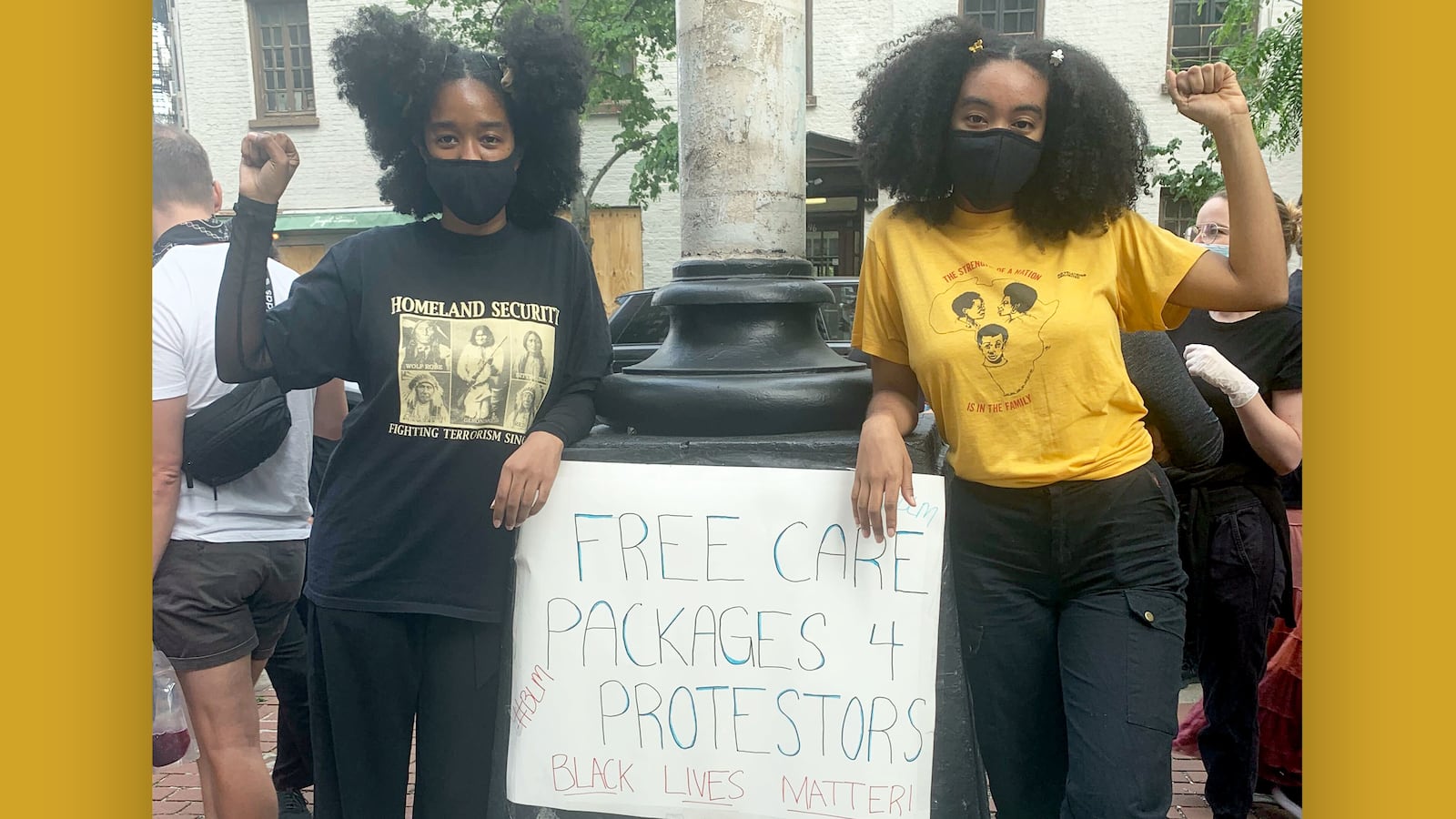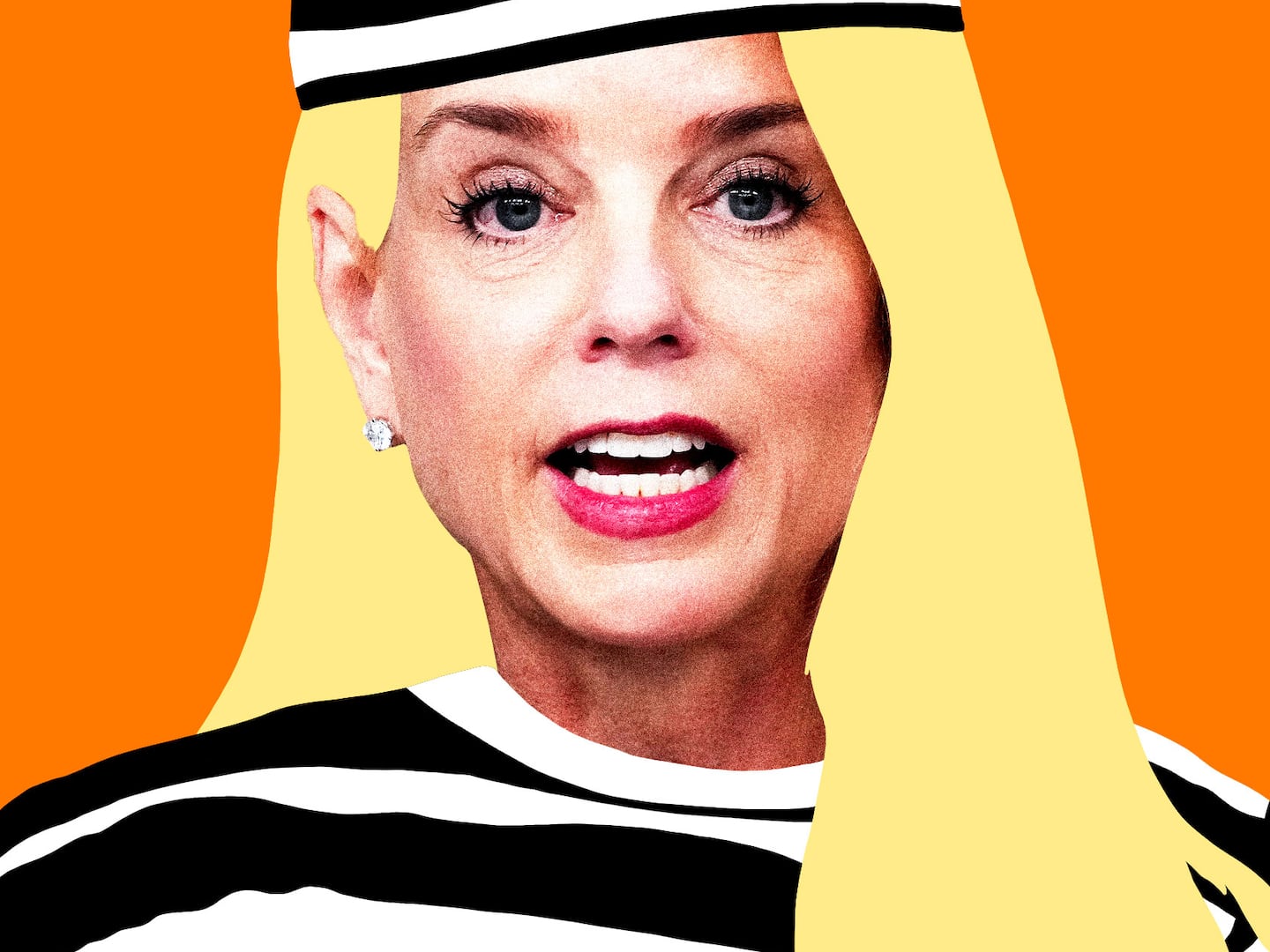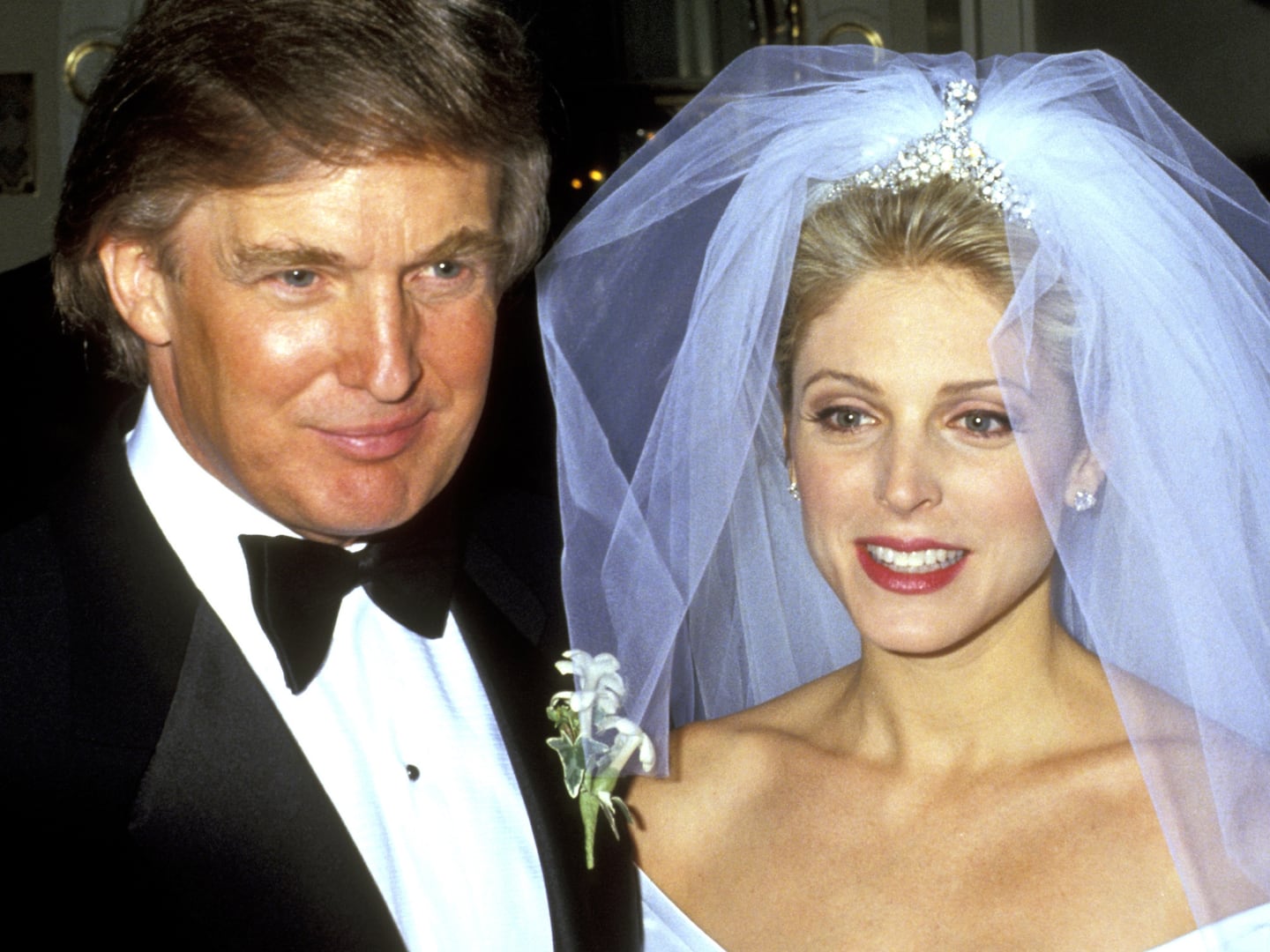“We’re not really warrior types,” Kira, 21, from the Bronx, said while standing directly across from the famed Stonewall Inn on Tuesday afternoon. “Being on the front lines is a little scary for us, but we want to show up and support the people who are marching, because they matter. We want to protect them as much as possible.”
So Kira, who uses they/them pronouns, packed up the family car and headed to Christopher Park to support those demonstrating for justice and equality in the wake of George Floyd's death.
Although Kira and their 17-year-old sister, Karla, were wearing black masks that covered most of their faces, their eyes lit up with easy, friendly smiles for every protester who passed. “Free water? Want some snacks?” they called out. (Like all the volunteers who spoke for this story, Kira and Karla did not give their last names.)
At 5 p.m., as a crowd carrying cardboard “Silence = Death” signs began to form, the pair set up shop at the base of a flagpole. They taped up placards advertising “Free Care Packages 4 Protestors.” Inside a striped beach tote were brown bags filled with water, Gatorade, a sandwich, face mask, and gloves.
They spent much of the previous Monday evening in their kitchen, researching how to make bulk anti-tear gas and pepper spray solution just “in case things get out of hand.”
“We found a protester in Chile who made the solution on Twitter,” Kira said. “So we just went in, mixing it in our kitchen.”
“Three spoonfuls of baking soda, one cup of water, mix,” Karla added.
This was their first protest. They spent the weekend “doing digital organizing—reposting resources, donation pages, videos, what have you,” Kira said.
The sister solicited funds on Instagram, asking their friends and followers to send cash for supplies. They raised around $4,000 in six hours.
“The community really showed out,” Kira said. “I got a Venmo [donation] that said, ‘Love from the west coast.’ I don’t even know that many people!”
“We’re still getting vibrations on our phones from friends pitching in,” Karla added. “They just want to give back as much as possible. If anyone needs anything, we have enough.”
Kira wanted people who were unable to protest to know that they could still open their wallets in solidarity. “People just want to show their love and appreciation,” she explained. “You don’t have to be on the front lines. You can be a healer. You can donate, use your money. There are so many ways to organize.”
The sisters were friends with some of the Stonewall protest speakers, though they had not seen them in person since before the pandemic began. “I identify as nonbinary, so it means a lot for me to be around queer people,” Kira said. “During coronavirus, I kept saying that I missed queer spaces so much. The queer community makes me shake. I love my identity and everyone who identifies under it.”
Near Kira and Karla, two women were giving out clementines, mini-water bottles, and packages of Oreos they were eager to advertise as double stuffed. The grocery cart they used to tote the provisions broke; they needed to unload quickly.
“This is just like the soccer moms who give out orange slices after a game,” said a woman with a “Dykes for BLM” cardboard sign as she carried away some water for herself and a friend.
A few feet away, a former barista named Griffin unloaded packages of water bottles from his friend’s red hatchback. The coffee shop he worked at closed during the pandemic, and he used money from this week’s unemployment check to cover the supplies.
“I live very frugally, so I’m trying to channel the excess money I have back into things that are productive for what’s going on now,” Griffin said. “I think in this moment, all you can do is try to materially support the cause. If you’re white you’re here in solidarity, but you also need to support materially. I’m giving out supplies to help with the cause, not to make myself feel good or something. It seems unconscionable to do nothing. But I don’t want to act like it’s a noble gesture; it’s just something that feels necessary.”
Griffin first attended a protest on Monday as a demonstrator. He saw others giving out water and snacks and decided that he wanted to as well. He went to the grocery store and bought $35 worth of supplies. “It wasn’t very much,” Griffin said. “Whatever I could fit into my bag to get here.”
He began his day aiding protesters at Foley Square near the Financial District. There Griffin ran into some friends who were also volunteering and had a car. That came in handy transporting more water bottles and clementines up to Stonewall.
“I don’t know how late we’ll be out tonight,” he added. “I guess until we run out of stuff.”
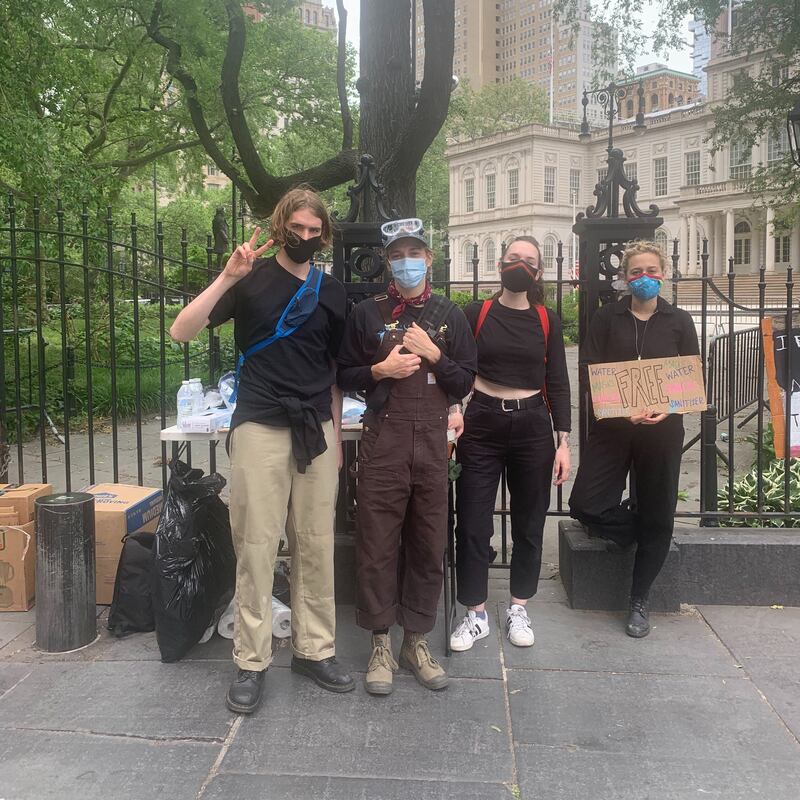
In Foley Square, New York City, Allen, Trevor, Mandy, and Lindsey from Queens hand out supplies on Tuesday.
Alaina Demopoulos/The Daily BeastA few hours earlier, a group of friends who live in Ridgewood, Queens, set up a folding table near Foley Square. One of them named Lindsay, a freelancer who works in production, wore a black jumpsuit as she passed out granola bars. In Hong Kong, she saw police use tear gas against protesters. It was a sight she never expected to witness in the United States.
“I don’t know how to describe how weird that feels,” Lindsay said. “It escalated very quickly. People were being very peaceful, and it was genuinely cops getting pissed. I’m having... I’m having a lot of weird feelings,” she said, her shoulders cowering in revulsion.
Over the weekend, Lindsay and her “protest pod” took a day off to strategize about how they could best serve the movement. “We wanted to make sure people are hydrated and safe, so we put together these kits,” she said.
Some friends asked if they could donate to the grocery fund; Lindsay declined. “We’re not going out and spending unemployment on anything else, so why not spend it on something we care about?” she shrugged.
With her whiskey-tinged voice and sleeve of tattoos, a woman named Mac passing out water and fruit to protesters nearby on Broadway looked every bit the former bartender she is. “I’m out of work, so I have nothing but time,” Mac said. “I’m going to be here every day.”
Mac went to her first demonstration on Saturday, where she noticed volunteers keeping people hydrated. “I was definitely one of the people who wasn’t prepared enough, so I benefited from those donations,” she said. Right before heading to the grocery store the next day, Mac put out a request for funds on Instagram.
By the time she left the supermarket, Mac already had $100 in her Venmo from followers who wanted to help. “It was friends, people I know, people I’ve met once,” she said. “My phone is constantly going off. I have about $800 now. A lot of it is from people who wish they could be here and are in complete support of this.”
One EMT named Andrew also walked through the crowd wearing mint-green scrubs. The word “MEDIC” was written on the duct tape across his backpack. He decided to attend the march on his day off. “I can’t just keep staying home,” he said.
Andrew attended protests in the past, but never as a medic. “I’m a little nervous, but I’ve been told to keep paying attention to what’s going on and not get distracted. Just be aware.” As he spoke, his eyes darted around the crowd. “I feel like I had to do something.”
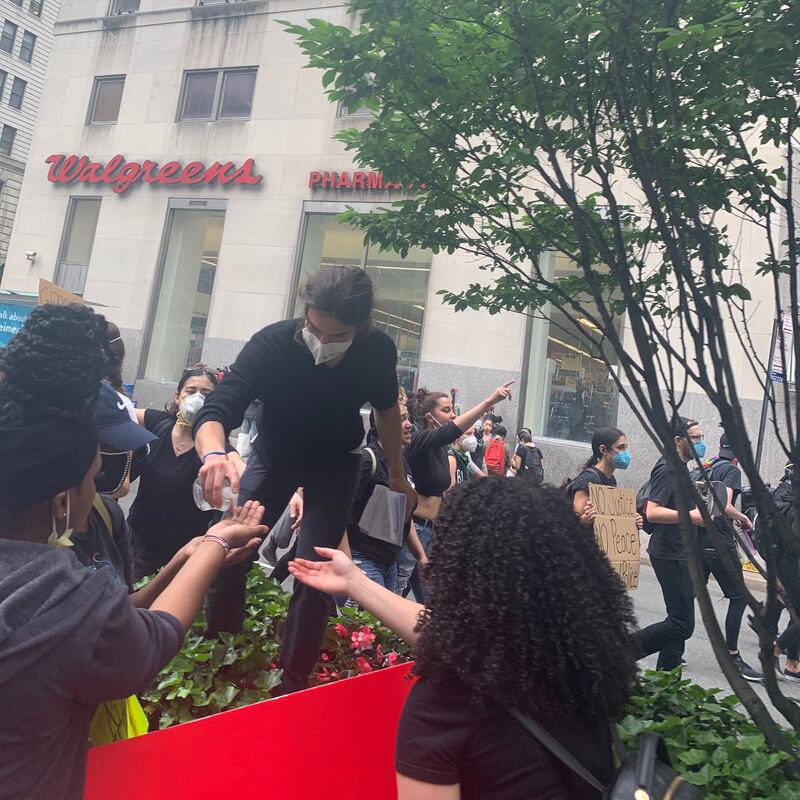
A volunteer shares hand sanitizer during the march up Park Avenue in the Flatiron neighborhood of New York City, Tuesday.
Alaina Demopoulos/The Daily BeastA few blocks up, sweaty demonstrators greeted a man named Todd with grateful smiles as he passed them cold water bottles that were wet with condensation. Like many others, he lost his job and had time to attend the midday protest.
“This is the first time I’ve made it out in person because of COVID-related concerns,” Todd said through a blue bandana. “However, that’s gone by the wayside as the temperature in America rises. I can’t have both concerns. Now if you can excuse me, I’ve got to give these waters out to people.”

